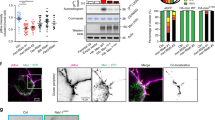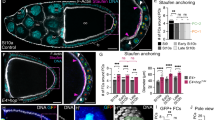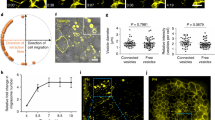Abstract
During development, elaborate patterns of cell differentiation and movement must occur in the correct locations and at the proper times. Developmental timing has been studied less than spatial pattern formation, and the mechanisms integrating the two are poorly understood. Border-cell migration in the Drosophila ovary occurs specifically at stage 9. Timing of the migration is regulated by the steroid hormone ecdysone, whereas spatial patterning of the migratory population requires localized activity of the JAK–STAT pathway. Ecdysone signalling is patterned spatially as well as temporally, although the mechanisms are not well understood. In stage 9 egg chambers, ecdysone signalling is highest in anterior follicle cells including the border cells. We identify the gene abrupt as a repressor of ecdysone signalling and border-cell migration. Abrupt protein is normally lost from border-cell nuclei during stage 9, in response to JAK–STAT activity. This contributes to the spatial pattern of the ecdysone response. Abrupt attenuates ecdysone signalling by means of a direct interaction with the basic helix–loop–helix (bHLH) domain of the P160 ecdysone receptor coactivator Taiman (Tai). Taken together, these findings provide a molecular mechanism by which spatial and temporal cues are integrated.
This is a preview of subscription content, access via your institution
Access options
Subscribe to this journal
Receive 12 print issues and online access
$209.00 per year
only $17.42 per issue
Buy this article
- Purchase on Springer Link
- Instant access to full article PDF
Prices may be subject to local taxes which are calculated during checkout








Similar content being viewed by others
References
Doe, C. Q. Chinmo and neuroblast temporal identity. Cell 127, 254–256 (2006).
Zhu, S. et al. Gradients of the Drosophila Chinmo BTB-zinc finger protein govern neuronal temporal identity. Cell 127, 409–422 (2006).
Kornberg, T. B. & Guha, A. Understanding morphogen gradients: a problem of dispersion and containment. Curr. Opin. Genet. Dev. 17, 264–271 (2007).
Moss, E. G. Heterochronic genes and the nature of developmental time. Curr. Biol. 17, R425–R434 (2007).
Frasch, M. A matter of timing: microRNA-controlled temporal identities in worms and flies. Genes Dev. 22, 1572–1576 (2008).
Karp, X. & Ambros, V. Developmental biology. Encountering microRNAs in cell fate signaling. Science 310, 1288–1289 (2005).
Ambros, V. MicroRNA pathways in flies and worms: growth, death, fat, stress, and timing. Cell 113, 673–676 (2003).
Riddiford, L. M. in The Development of Drosophila melanogaster (eds Bate, M. & Arias, A. M.) 899–929 (Cold Spring Harbor Laboratory Press, 1993).
Banerjee, I. & Clayton, P. The genetic basis for the timing of human puberty. J. Neuroendocrinol. 19, 831–838 (2007).
Carel, J. C. & Leger, J. Clinical practice. Precocious puberty. N. Engl. J. Med. 358, 2366–2377 (2008).
Naora, H. & Montell, D. J. Ovarian cancer metastasis: integrating insights from disparate model organisms. Nature Rev. Cancer 5, 355–366 (2005).
Montell, D. J. Border-cell migration: the race is on. Nature Rev. Mol. Cell Biol. 4, 13–24 (2003).
Rorth, P. Initiating and guiding migration: lessons from border cells. Trends Cell Biol. 12, 325–331 (2002).
Bai, J., Uehara, Y. & Montell, D. J. Regulation of invasive cell behavior by taiman, a Drosophila protein related to AIB1, a steroid receptor coactivator amplified in breast cancer. Cell 103, 1047–1058 (2000).
Schwartz, M. B., Kelly, T. J., Woods, C. W. & Imberski, R. B. Ecdysteroid fluctuations in adult Drosophila melanogaster caused by elimination of pupal reserves and synthesis by early vitellogenic ovarian follicles. Insect Biochem. 19, 243–249 (1989).
Buszczak, M. et al. Ecdysone response genes govern egg chamber development during mid-oogenesis in Drosophila. Development 126, 4581–4589 (1999).
Gaziova, I., Bonnette, P. C., Henrich, V. C. & Jindra, M. Cell-autonomous roles of the ecdysoneless gene in Drosophila development and oogenesis. Development 131, 2715–2725 (2004).
Carney, G. E. & Bender, M. The Drosophila ecdysone receptor (EcR) gene is required maternally for normal oogenesis. Genetics 154, 1203–1211 (2000).
Silver, D. L. & Montell, D. J. Paracrine signaling through the JAK/STAT pathway activates invasive behavior of ovarian epithelial cells in Drosophila. Cell 107, 831–841 (2001).
Xi, R., McGregor, J. R. & Harrison, D. A. A gradient of JAK pathway activity patterns the anterior–posterior axis of the follicular epithelium. Dev. Cell 4, 167–177 (2003).
Silver, D. L., Geisbrecht, E. R. & Montell, D. J. Requirement for JAK/STAT signaling throughout border cell migration in Drosophila. Development 132, 3483–3492 (2005).
Starz-Gaiano, M., Melani, M., Wang, X., Meinhardt, H. & Montell, D. J. Feedback inhibition of Jak/STAT signaling by apontic is required to limit an invasive cell population. Dev. Cell 14, 726–738 (2008).
Kozlova, T. & Thummel, C. S. Essential roles for ecdysone signaling during Drosophila mid-embryonic development. Science 301, 1911–1914 (2003).
Hackney, J. F., Pucci, C., Naes, E. & Dobens, L. Ras signaling modulates activity of the ecdysone receptor EcR during cell migration in the Drosophila ovary. Dev. Dyn. 236, 1213–1226 (2007).
Cherbas, L., Hu, X., Zhimulev, I., Belyaeva, E. & Cherbas, P. EcR isoforms in Drosophila: testing tissue-specific requirements by targeted blockade and rescue. Development 130, 271–284 (2003).
Kozlova, T. & Thummel, C. S. Spatial patterns of ecdysteroid receptor activation during the onset of Drosophila metamorphosis. Development 129, 1739–1750 (2002).
Rubenstein, E. C., Kelly, T. J., Schwartz, M. B. & Woods, C. W. In vitro synthesis and secretion of ecdysteroids by Drosophila melanogaster ovaries. J. Exp. Zool. 223, 305–308 (1982).
Chavez, V. M. et al. The Drosophila disembodied gene controls late embryonic morphogenesis and codes for a cytochrome P450 enzyme that regulates embryonic ecdysone levels. Development 127, 4115–4126 (2000).
Freeman, M. R., Dobritsa, A., Gaines, P., Segraves, W. A. & Carlson, J. R. The dare gene: steroid hormone production, olfactory behavior, and neural degeneration in Drosophila. Development 126, 4591–4602 (1999).
Petryk, A. et al. Shade is the Drosophila P450 enzyme that mediates the hydroxylation of ecdysone to the steroid insect molting hormone 20-hydroxyecdysone. Proc. Natl Acad. Sci. USA 100, 13773–13778 (2003).
Warren, J. T. et al. Molecular and biochemical characterization of two P450 enzymes in the ecdysteroidogenic pathway of Drosophila melanogaster. Proc. Natl Acad. Sci. USA 99, 11043–11048 (2002).
Warren, J. T. et al. Phantom encodes the 25-hydroxylase of Drosophila melanogaster and Bombyx mori: a P450 enzyme critical in ecdysone biosynthesis. Insect Biochem. Mol. Biol. 34, 991–1010 (2004).
Schubiger, M., Tomita, S., Sung, C., Robinow, S. & Truman, J. W. Isoform specific control of gene activity in vivo by the Drosophila ecdysone receptor. Mech. Dev. 120, 909–918 (2003).
Hu, S., Fambrough, D., Atashi, J. R., Goodman, C. S. & Crews, S. T. The Drosophila abrupt gene encodes a BTB-zinc finger regulatory protein that controls the specificity of neuromuscular connections. Genes Dev. 9, 2936–2948 (1995).
Li, W., Wang, F., Menut, L. & Gao, F. B. BTB/POZ-zinc finger protein abrupt suppresses dendritic branching in a neuronal subtype-specific and dosage-dependent manner. Neuron 43, 823–834 (2004).
Sugimura, K., Satoh, D., Estes, P., Crews, S. & Uemura, T. Development of morphological diversity of dendrites in Drosophila by the BTB-zinc finger protein abrupt. Neuron 43, 809–822 (2004).
Yan, J., Tsai, S. Y. & Tsai, M. J. SRC-3/AIB1: transcriptional coactivator in oncogenesis. Acta Pharmacol. Sin. 27, 387–394 (2006).
Lee, T. & Luo, L. Mosaic analysis with a repressible cell marker for studies of gene function in neuronal morphogenesis. Neuron 22, 451–461 (1999).
Harrison, D. A., Binari, R., Nahreini, T. S., Gilman, M. & Perrimon, N. Activation of a Drosophila Janus kinase (JAK) causes hematopoietic neoplasia and developmental defects. EMBO J. 14, 2857–2865 (1995).
Tam, P. P. & Loebel, D. A. Gene function in mouse embryogenesis: get set for gastrulation. Nature Rev. Genet. 8, 368–381 (2007).
Lander, A. D. Morpheus unbound: reimagining the morphogen gradient. Cell 128, 245–256 (2007).
Maurange, C., Cheng, L. & Gould, A. P. Temporal transcription factors and their targets schedule the end of neural proliferation in Drosophila. Cell 133, 891–902 (2008).
Sokol, N. S., Xu, P., Jan, Y. N. & Ambros, V. Drosophila let-7 microRNA is required for remodeling of the neuromusculature during metamorphosis. Genes Dev. 22, 1591–1596 (2008).
Caygill, E. E. & Johnston, L. A. Temporal regulation of metamorphic processes in Drosophila by the let-7 and miR-125 heterochronic microRNAs. Curr. Biol. 18, 943–950 (2008).
Ambros, V. & Horvitz, H. R. Heterochronic mutants of the nematode Caenorhabditis elegans. Science 226, 409–416 (1984).
Sempere, L. F., Sokol, N. S., Dubrovsky, E. B., Berger, E. M. & Ambros, V. Temporal regulation of microRNA expression in Drosophila melanogaster mediated by hormonal signals and broad-Complex gene activity. Dev. Biol. 259, 9–18 (2003).
Sempere, L. F., Dubrovsky, E. B., Dubrovskaya, V. A., Berger, E. M. & Ambros, V. The expression of the let-7 small regulatory RNA is controlled by ecdysone during metamorphosis in Drosophila melanogaster. Dev. Biol. 244, 170–179 (2002).
Bashirullah, A. et al. Coordinate regulation of small temporal RNAs at the onset of Drosophila metamorphosis. Dev. Biol. 259, 1–8 (2003).
Rorth, P. et al. Systematic gain-of-function genetics in Drosophila. Development 125, 1049–1057 (1998).
Manseau, L. et al. GAL4 enhancer traps expressed in the embryo, larval brain, imaginal discs, and ovary of Drosophila. Dev. Dyn. 209, 310–322 (1997).
McGuire, S. E., Mao, Z. & Davis, R. L. Spatiotemporal gene expression targeting with the TARGET and gene-switch systems in Drosophila. Sci. STKE 2004, pl6 (2004).
Yao, J. G. & Sun, Y. H. Eyg and Ey Pax proteins act by distinct transcriptional mechanisms in Drosophila development. EMBO J. 24, 2602–2612 (2005).
Wang, X. et al. Analysis of cell migration using whole-genome expression profiling of migratory cells in the Drosophila ovary. Dev. Cell 10, 483–495 (2006).
Geisbrecht, E. R. & Montell, D. J. A role for Drosophila IAP1-mediated caspase inhibition in Rac-dependent cell migration. Cell 118, 111–125 (2004).
Tsai, C. C., Kao, H. Y., Yao, T. P., McKeown, M. & Evans, R. M. SMRTER, a Drosophila nuclear receptor coregulator, reveals that EcR-mediated repression is critical for development. Mol. Cell 4, 175–186 (1999).
Acknowledgements
This work was supported by NIH grants R01 GM46425 and R01 GM73164 to D.J.M.
Author information
Authors and Affiliations
Contributions
In Figs 3 and 8, A.J. and Y.C. contributed equally. A.J. also contributed Figs 1, 2, 4, 5, 6, 7 and Supplementary Information, Figs S1, S3, S4, S5 and S6. The EP screen was performed by Y.C., who also conducted the mutant analysis of Abrupt for Supplementary Information, Fig. S2. The nls-Tai(LXXLL–GFP) transgenic flies were constructed by J.B.. D.M. conceived of the project, participated in experimental design, discussions of results and interpretations, and wrote the manuscript.
Corresponding author
Ethics declarations
Competing interests
The authors declare no competing financial interests.
Supplementary information
Supplementary Information
Supplementary Information (PDF 1147 kb)
Rights and permissions
About this article
Cite this article
Jang, AC., Chang, YC., Bai, J. et al. Border-cell migration requires integration of spatial and temporal signals by the BTB protein Abrupt. Nat Cell Biol 11, 569–579 (2009). https://doi.org/10.1038/ncb1863
Received:
Accepted:
Published:
Issue Date:
DOI: https://doi.org/10.1038/ncb1863
This article is cited by
-
Transcriptome analysis reveals temporally regulated genetic networks during Drosophila border cell collective migration
BMC Genomics (2023)
-
Nuclear receptors connect progenitor transcription factors to cell cycle control
Scientific Reports (2017)
-
Steroid Hormones and the Physiological Regulation of Tissue-Resident Stem Cells: Lessons from the Drosophila Ovary
Current Stem Cell Reports (2017)
-
Apontic regulates somatic stem cell numbers in Drosophila testes
BMC Developmental Biology (2016)
-
Tissue landscape alters adjacent cell fates during Drosophila egg development
Nature Communications (2015)



